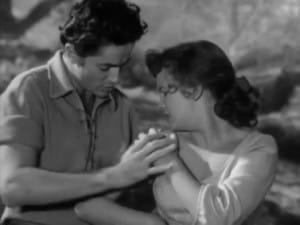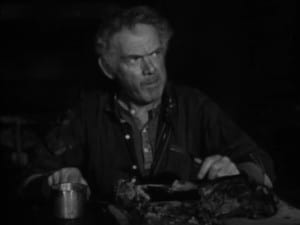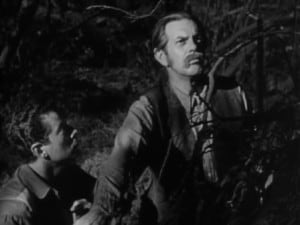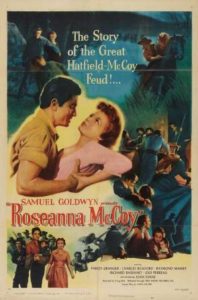Billed as containing all of the drama of the real life Hatfield and McCoy feud, in 1949 Samuel Goldwyn released Roseanna McCoy. He put together an extremely strong cast, with Raymond Massey and Charles Bickford as the two patriarchs of the McCoys and Hatfields, respectively. Additional ammunition was added for the Hatfields in the form of Richard Basehart as Mounts Hatfield.
But what of the lead characters, you say? We start well with Farley Granger as Johnse Hatfield. Across from him is Joan Evans in the title role of Roseanna McCoy. If you aren’t familiar with Joan Evans, you are not alone. I had to look her up myself.
She was the winner of a talent search that Samuel Goldwyn held to fill the role of Roseanne. Named after Joan Crawford, she was only 14 at the time she won the role, though for legal reasons her parents claimed she was 16 at the time. She had a fairly short career in films and television before retiring in 1961. Aside from Roseanna McCoy, she stared with Farley Granger in two other films.
Roseanna McCoy really ends up being two films joined together from what all concerned clearly felt was a disjointed production. With a completely unfinished script, Irving Reis took the directorial helm but could do little but film establishing shots until the dialogue began to be delivered to the set. Even then, it was disjointed and rewritten and Reis frequently clashed with one of his stars, Farley Granger.
 For unknown reasons, though likely because of the surely ramshackle results, Nicholas Ray was brought in to salvage the project after the initial shooting schedule wrapped. With some reporting he only shot retakes and other claiming a more extensive involvement, it is unclear how much if any of Ray’s work is in the final film. Reis received the only onscreen credit, for which Ray was surely thankful.
For unknown reasons, though likely because of the surely ramshackle results, Nicholas Ray was brought in to salvage the project after the initial shooting schedule wrapped. With some reporting he only shot retakes and other claiming a more extensive involvement, it is unclear how much if any of Ray’s work is in the final film. Reis received the only onscreen credit, for which Ray was surely thankful.
The first part of the film, which tries to be a coherent thread for the entire feature, is a love story between Johnse and Roseanne, the products of two warring families. Though there is a good scene when they meet and Johnse sucks hornet venom from a recent sting on her arm, the relationship never carries any believability.
In a slightly later scene Johnse hints at what could have been a potential rape scenario, although perhaps the implication is more the urgency of his desire rather than actual fact. In either case Roseanna casts her lot with him and never looks back.
 Having met, they immediately fall in love and Roseanna decides to head for Hatfield country to meet Johnse’s parents. This she duly does, where she meets Charles Bickford in the form of Devil Anse Hatfield. Always known for his gruff and surly characters, Bickford gives tremendous credibility to the story, and helps take it in a somewhat different direction.
Having met, they immediately fall in love and Roseanna decides to head for Hatfield country to meet Johnse’s parents. This she duly does, where she meets Charles Bickford in the form of Devil Anse Hatfield. Always known for his gruff and surly characters, Bickford gives tremendous credibility to the story, and helps take it in a somewhat different direction.
With the feud having gone a bit cold of late, Anse uses Roseanna’s near-elopement as kindling to get the families in arms again. Roseanna goes back and forth between the two sets of parents (her own and her future inlaws) in a piece of the film which should have been developed more.
 Also in the middle third we come across the psychotic Mount Hatfield, played by Richard Basehart. Though Basehart (who excelled in playing the mentally slightly off) is wickedly demonic- especially in the shooting of a McCoy preteen, his plot thread really has no purpose, except perhaps adding more fuel to the McCoy side of the bonfire, which frankly isn’t needed. If your leader’s daughter is captured (as they would view it, anyway) by the enemy, is there much that could increase your ire? Not likely so.
Also in the middle third we come across the psychotic Mount Hatfield, played by Richard Basehart. Though Basehart (who excelled in playing the mentally slightly off) is wickedly demonic- especially in the shooting of a McCoy preteen, his plot thread really has no purpose, except perhaps adding more fuel to the McCoy side of the bonfire, which frankly isn’t needed. If your leader’s daughter is captured (as they would view it, anyway) by the enemy, is there much that could increase your ire? Not likely so.
Now fully involved, both families get themselves armed to the teeth and slug it out from opposing sides of the river, stopping only when they see Johnse and Roseanne together on horseback crossing to escape the melee.
The buildup to this “second” picture, which is the gunfight between the two clans, ends up taking over the picture. One thinks that ideally this would have been the culmination of the love affair between Johnse and Roseanna, but I get the feeling that the producers realized in the rushes that their leading lady was unable to carry it off. To compensate the focus shifts to the relations between the two families and Johnse does most of the heavy lifting.
 Granger does much better in the second half of the picture, when he is given a wider and more experienced set of cast members to work with. Strangely Johnse seems to be a bit disengaged with the family paradigm.
Granger does much better in the second half of the picture, when he is given a wider and more experienced set of cast members to work with. Strangely Johnse seems to be a bit disengaged with the family paradigm.
Looking overwhelmed, Miss Evans seems unable to play the romantic aspects of her part as needed (as perhaps the context to draw on from her own life experience wasn’t present at the age of 14), and Granger seems to struggle finding someone to play against.
Where Evans is effective, however, is that middle third of the picture where she has candid talks with both her soon to be mother-in-law and her own mother. In a portion of the film that should have been developed further, we see that the families are much the same.
 Both have exceptionally strong patriarchs (with Raymond Massey no less effective as the head of the McCoy family) and are devoutly religious. Though hints are made at the Hatfield’s perceived sense of impoverishment compared to the McCoys, both families are in fact of the same social strata; hardworking rural families doing their best in a troubled time. There could have been a play made for a moralistic bent as a result, but the film takes no such course.
Both have exceptionally strong patriarchs (with Raymond Massey no less effective as the head of the McCoy family) and are devoutly religious. Though hints are made at the Hatfield’s perceived sense of impoverishment compared to the McCoys, both families are in fact of the same social strata; hardworking rural families doing their best in a troubled time. There could have been a play made for a moralistic bent as a result, but the film takes no such course.
Roseanna McCoy has some beautiful exteriors, no doubt resulting from the additional time given the problems that the script presented. Outside of these longer distance setup shots, there is little of visual interest in the picture. Even given some of the quality ingredient in the picture – most notably the supporting cast, it never manages to overcome the challenges created by a cobbled together script and a woefully under-experienced female lead.
